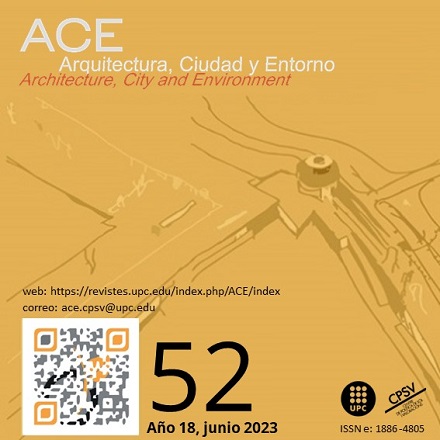Antigraffiti Protectors on Earthen Walls: Water Risk Analysis
DOI:
https://doi.org/10.5821/ace.18.52.11841Keywords:
adobe, vandalism, conservation, architectureAbstract
There is currently a wide variety of anti-graffiti products of a different chemical nature on the market, permanent (xyloxanes, silicates, polyurethanes, fluorinated polymers, nanocomposites, etc.) and non-permanent (paraffins, acrylates and polysaccharides), as a protective coating for monuments against the phenomenon of vandalism graffiti. All of them have a water-repellent action on the substrate that is applied but, in the specific case of earthen walls, due to the intrinsic properties of the clayey material that makes it up and its high proportion in its composition (up to 20%), it can make it impossible to eliminate the water retained inside it by creating an impermeable barrier on the surface. On the other hand, the high hygroscopic character of the clay, with moisture absorption or desorption depending on the RH of the environment, can cause a retraction/dilation in the different strata and the consequent formation of cracks. The study carried out -according to UNE standards- of the coefficients of water absorption by capillarity in adobe samples at controlled intervals of time, as well as its desorption, has made it possible to determine the behaviour of adobe against this phenomenon when it is protected on the surface by an antigraffiti of the two analysed groups. Likewise, through Scanning Electron Microscopy (SEM-EDX) the modifications suffered by the superficial layer due to the hygroscopic nature of the support have been observed. The final diagnosis has determined that anti-graffiti protection on earthen walls is extremely dangerous when there is a high level of humidity.
Downloads
Published
Issue
Section
License
| INTELECTUAL PROTECTION CRITERIA |
At this moment, it is count with the "Oficina Española de Patentes y Marcas", while global protection it is being processed by the World Intelectual Property Organization (OMPI/WIPO). Nevertheless the International Standard Serial Number Office (ISSN) has given the following numbers ISSN: 1886-4805 (electronic version) and 1887-7052 (paper version). All articles will be peer reviewed, using double blind reviewing. |
| COPYRIGHT |
The article contents and their comments are authors exclusive liability, and do not reflect necessarily the journal editor commitee's opinion. All ACE published works are subject to the following licence CC BY-NC-ND 3.0 ES http://creativecommons.org/licenses/by-nc-nd/3.0/es/ It implies that authors do not hold nor retain the copyright without restrictions but only those included in the licence. |


































